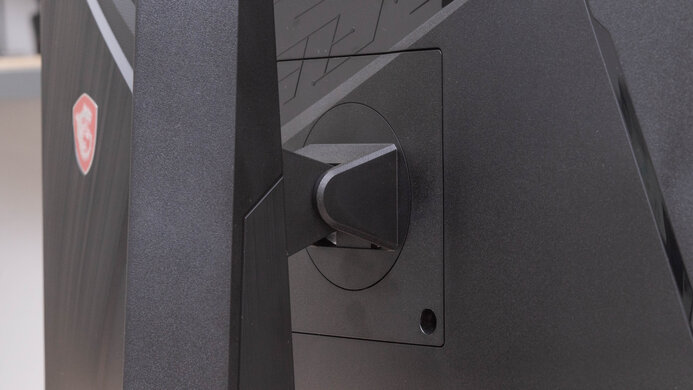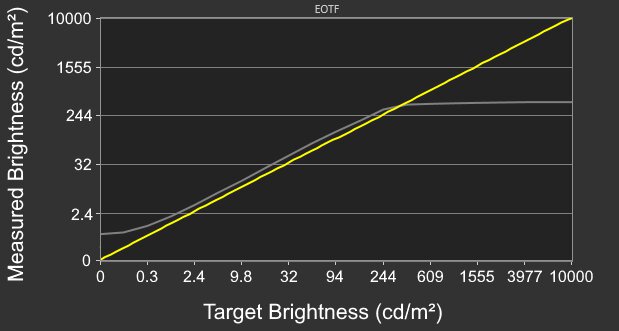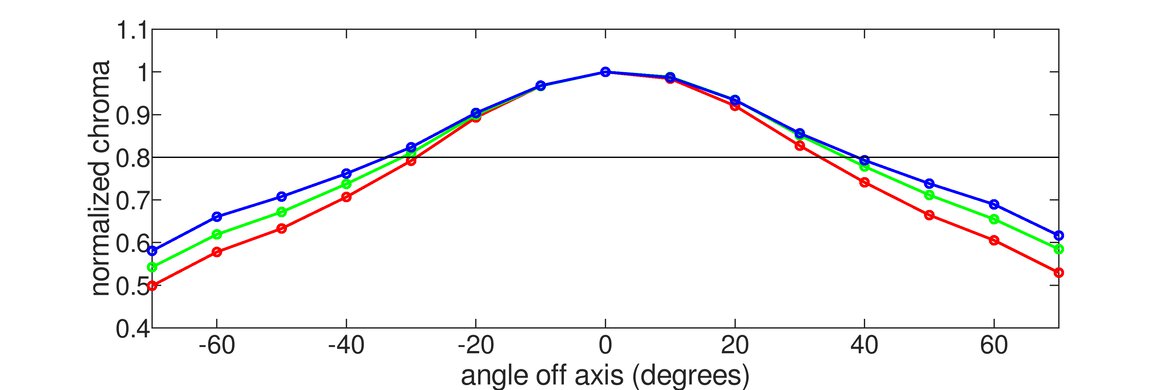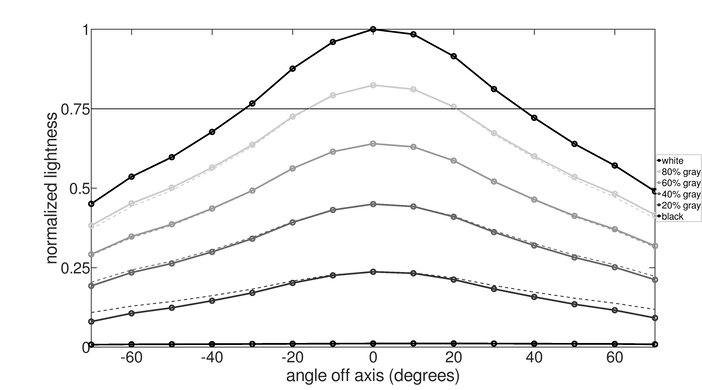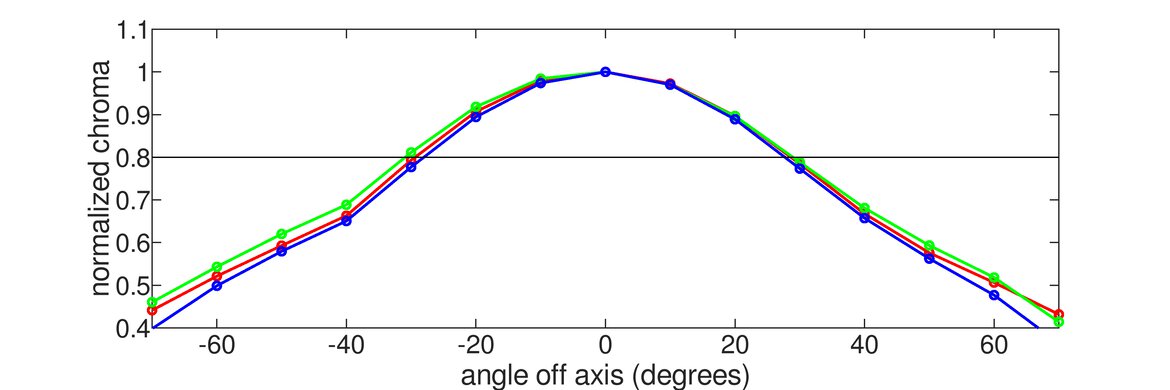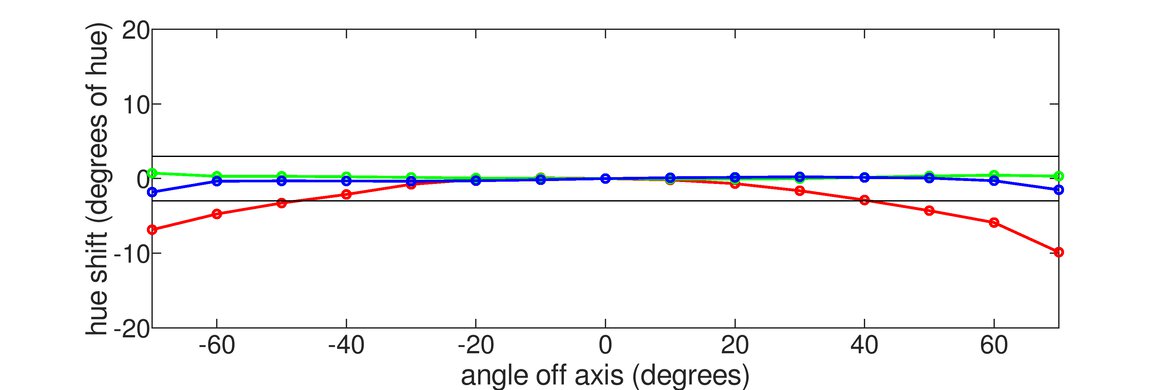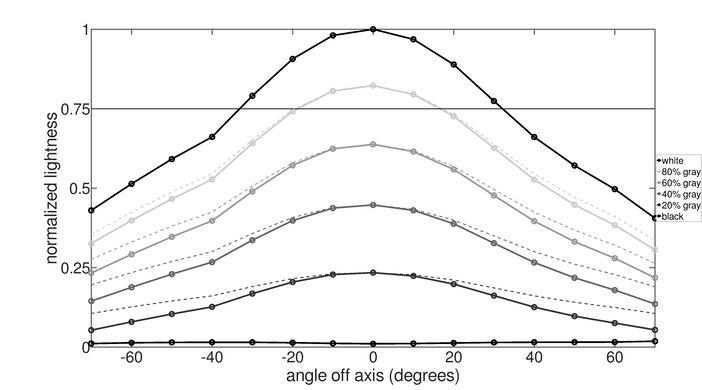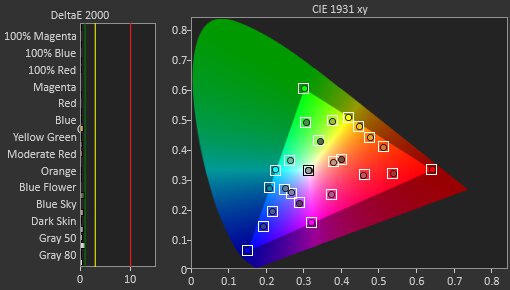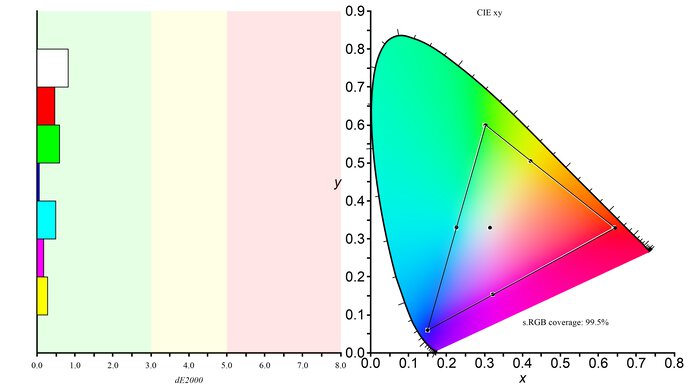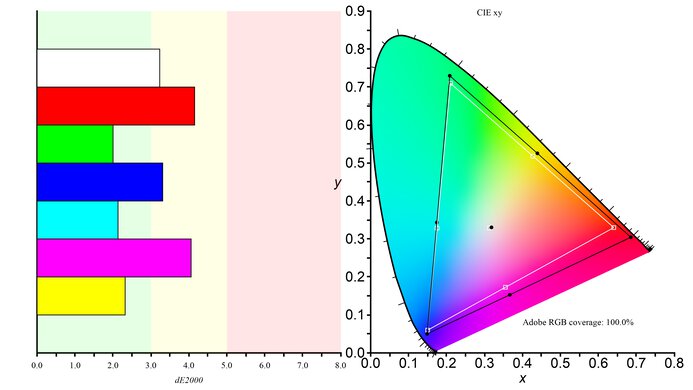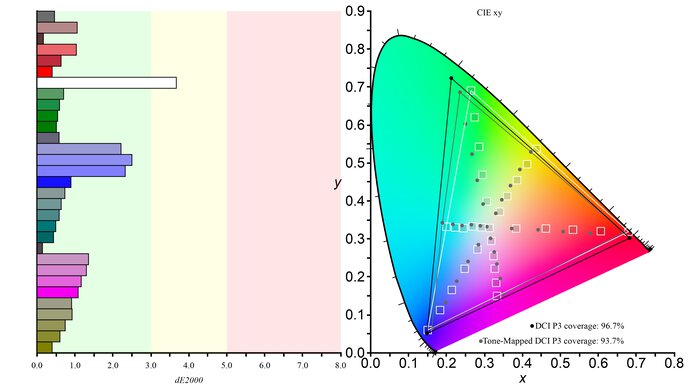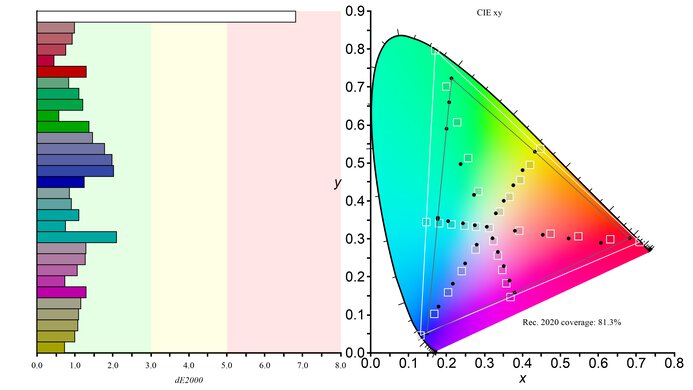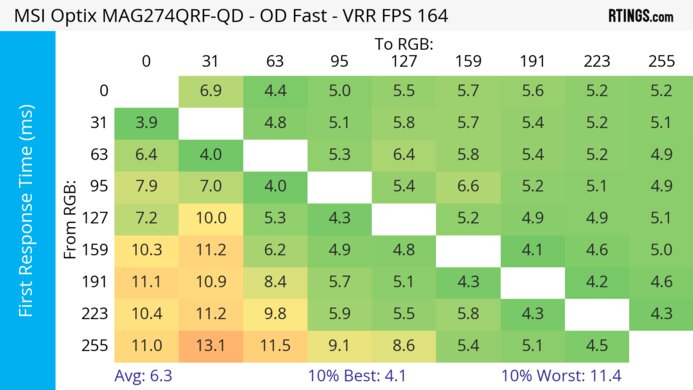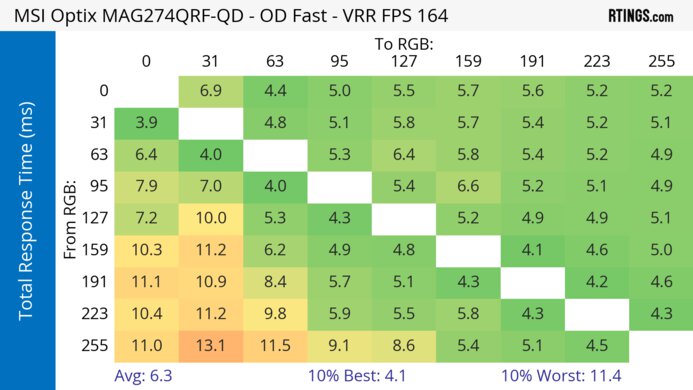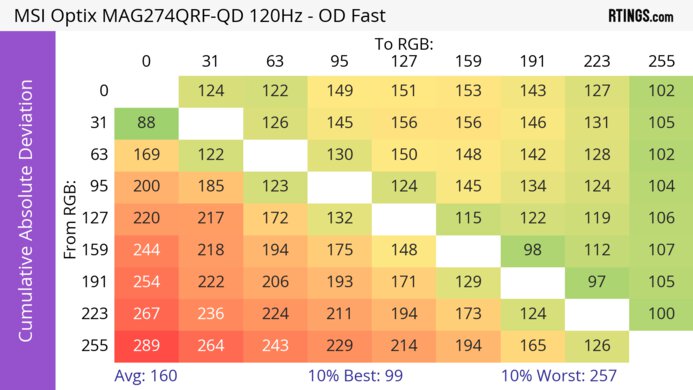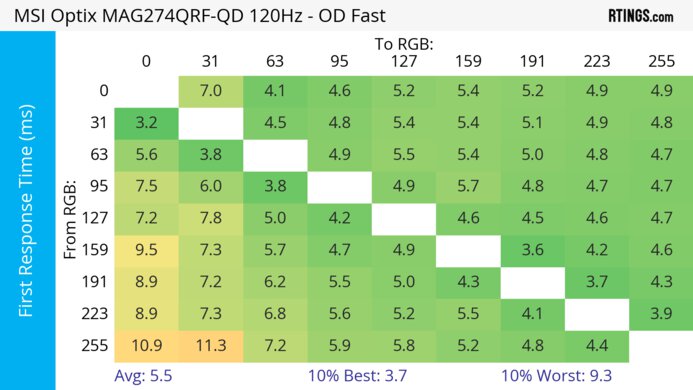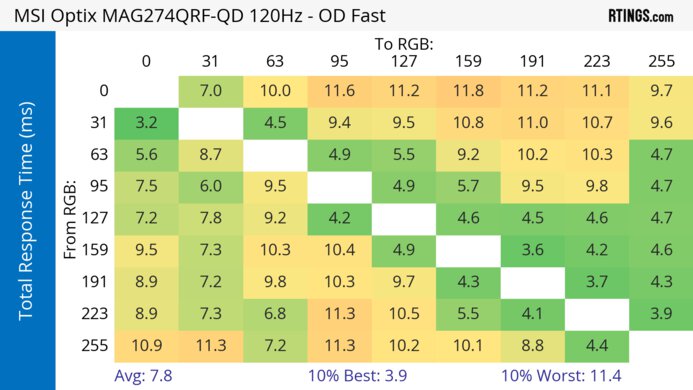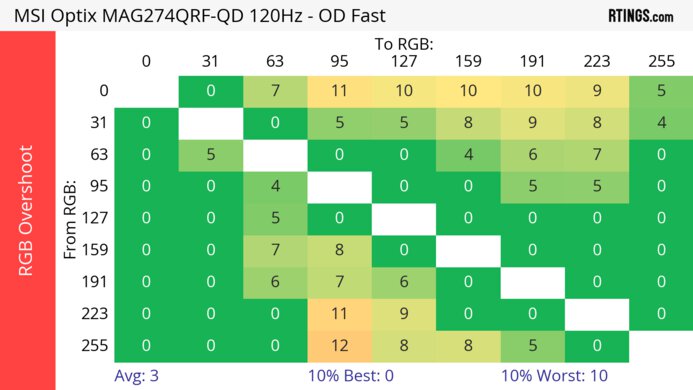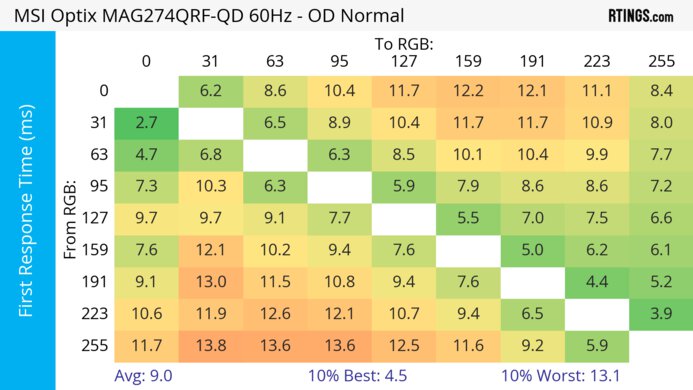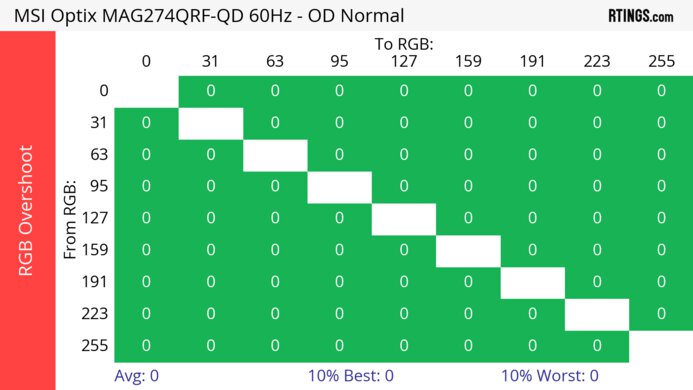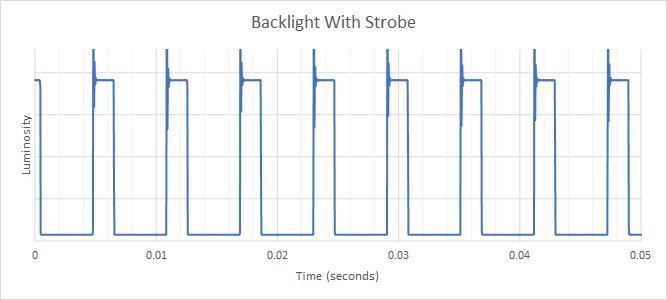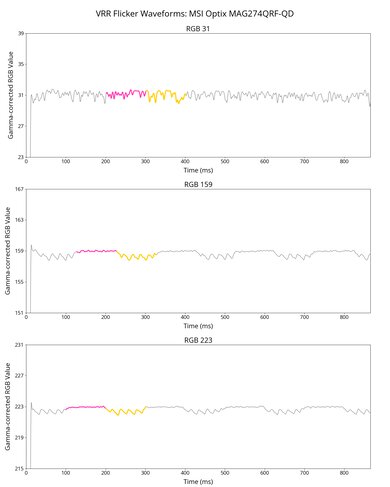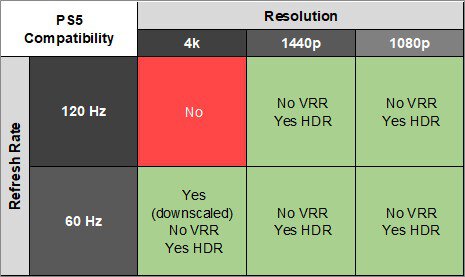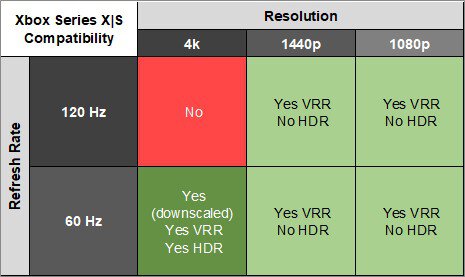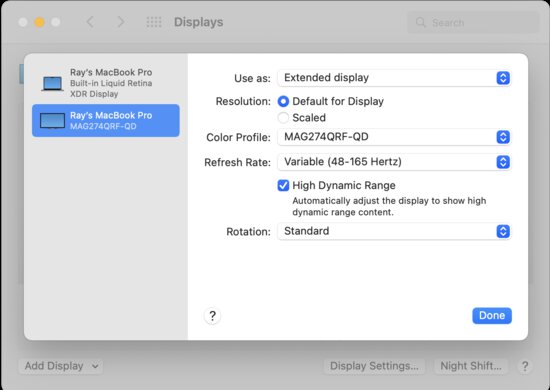The MSI Optix MAG274QRF-QD is a 1440p gaming monitor with a 165Hz refresh rate. As a part of the MSI MAG monitor lineup, it sits alongside the MSI Optix MG274QRF, which is a similar monitor but doesn't have a quantum dot layer like this monitor. It has features you'd expect to find in a gaming monitor, like G-SYNC compatibility and RGB backlighting, and it has a Console Mode that downscales 4k signals from consoles. It also has a USB hub that includes two USB-A ports and a USB-C slot for you to connect your devices.
Our Verdict
The MSI Optix MAG274QRF-QD is decent for PC gaming. It has a 165Hz refresh rate with native FreeSync support and G-SYNC compatibility to reduce screen tearing. It has low input lag for a responsive feel and a fast enough response time for sharp motion, but there's more inverse ghosting at lower refresh rates. Unfortunately, it has limited picture quality as blacks look gray, and it fails to make highlights stand out in HDR.
- 165Hz refresh rate and VRR support.
- Fast response time at high refresh rates.
- Extremely low input lag.
- Low contrast ratio.
- More blur at 60Hz.
- Highlights don't pop in HDR.
The MSI Optix MAG274QRF-QD 27 is okay for console gaming. Although it lacks HDMI 2.1 bandwidth to take full advantage of the PS5 and Xbox Series X|S, there aren't any compatibility issues with either console. It has low input lag for a responsive feel, and it has a fast response time at 120Hz, but there's more blur at 60Hz. Sadly, it's a poor choice for playing HDR games as it has a low contrast ratio, and it lacks a local dimming feature to further improve it.
- Fast response time at high refresh rates.
- Extremely low input lag.
- Low contrast ratio.
- More blur at 60Hz.
- Can't take full advantage of consoles.
The MSI Optix MAG274QRF-QD is good for office use. It has a large, high-resolution screen that delivers clear text. The ergonomics are fantastic, and it has wide viewing angles, making it easy to share your screen with someone else. It also gets bright enough to combat glare and has decent reflection handling in well-lit rooms.
- Wide viewing angles.
- Fantastic ergonomics.
- Bright enough to fight glare.
- Colors are oversaturated.
The MSI Optix MAG274QRF-QD is decent for content creators. It displays a wide range of colors, but they look oversaturated, and you need to get it calibrated for the best accuracy. It also has limited picture quality in HDR with a low contrast ratio and brightness. On the plus side, it has wide viewing angles and great ergonomics, allowing you to easily share your screen with a client or coworker.
- Wide viewing angles.
- Fantastic ergonomics.
- Bright enough to fight glare.
- Colors are oversaturated.
- Low contrast ratio.
The MSI MAG274QRF-QD has decent brightness. It gets bright enough to fight glare in most well-lit rooms, but highlights don't pop in HDR.
- Bright enough to fight glare.
- Highlights don't pop in HDR.
The MSI MAG274QRF-QD has a good response time. Motion looks best at high refresh rates, but there's more inverse ghosting and blur at lower refresh rates.
- Fast response time at high refresh rates.
- More blur at 60Hz.
The MSI MAG274QRF-QD has limited HDR picture quality. With low contrast and no local dimming feature, blacks look gray in the dark, and most colors don't look vivid either.
- Low contrast ratio.
- No local dimming.
The MSI MAG274QRF-QD has decent SDR picture quality. Its main advantage is that it displays a wide range of colors, but it has a low contrast ratio making blacks look gray in dark rooms.
- Displays wide range of colors.
- Low contrast ratio.
The MSI MAG274QRF-QD has good color accuracy, but you need to calibrate it for the best accuracy, as there are issues before calibration.
- Good gray uniformity.
- Colors are oversaturated.
Performance Usages
Changelog
- Updated Feb 21, 2025: We've converted this review to Test Bench 2.0.1. This includes a new test result for DisplayPort 2.1 Transmission Bandwidth.
- Updated May 21, 2024: Updated text throughout the review according to Test Bench 2.0, mainly in the Verdict and Motion sections.
- Updated May 16, 2024: We've converted this review to Test Bench 2.0. This includes new tests for VRR Motion Performance, Refresh Rate Compliance, Cumulative Absolute Deviation (CAD), and VRR Flicker. You can read the full changelog here.
- Updated Apr 18, 2023: Confirmed that 1440p works on this monitor with the PS5.
Check Price
Differences Between Sizes And Variants
We tested the 27-inch MSI Optix MAG274QRF-QD 27, which is only available in this size. The MSI Optix MAG274QRF is also available, which has many of the same features, but doesn't have a quantum dot layer like the MAG274QRF-QD, so it performs differently. The results of this review are only valid for the MAG274QRF-QD.
| Model | Size | Resolution | Refresh Rate | Quantum Dot |
|---|---|---|---|---|
| MAG274QRF-QD | 27" | 1440p | 165Hz | Yes |
| MAG274QRF | 27" | 1440p | 165Hz | No |
Our unit was manufactured in October 2020, and you can see our label here.
Popular Monitor Comparisons
The MSI Optix MAG274QRF-QD is a decent PC gaming monitor that has features you'd expect to find in a gaming monitor, like VRR support, low input lag, and a fast response time. Its quantum dot layer is unique for a monitor in this price range, but it also oversaturates colors. While it's a good choice for its price range, there's nothing that really stands out versus the competition, and you can get better value for gaming with a monitor like the Dell G2724D.
Also, see our recommendations for the best 1440p monitors, the best monitors for PS5/PS5 Pro, and the best gaming monitors.
The MSI Optix MAG274QRF-QD and the MSI G274QPF-QD are very similar 27-inch gaming monitors. However, the MAG274QRF-QD is the better monitor for most people, as it has better black uniformity, so deep blacks appear less cloudy in a dark room, and it also has more vibrant HDR colors. Additionally, the MAG274QRF-QD has a faster response time, so fast-moving images look sharper.
The MSI Optix MAG274QRF-QD and the LG 27GP850-B/27GP83B-B are similar 1440p, 27-inch monitors, but there are a few differences. The MSI has a few extra features for office use, like an ergonomic stand and a USB-C input that supports DisplayPort Alt Mode. However, the colors look oversaturated, and the color accuracy is much better on the LG. The LG is also slightly better for gaming because it supports DP 1.4 bandwidth, allowing you to reach a higher refresh rate, and the motion handling is a bit better with lower frame rate signals.
Overall, the MSI Optix MAG274QRF-QD performs better than the ASUS TUF Gaming VG27AQL1A. The MSI has a much faster response time to deliver a clearer image in fast-moving scenes. It has a much wider color gamut for HDR due to its quantum dot layer; however, it doesn't get as bright as the ASUS to bring out highlights in HDR content. The MSI has more USB ports, including a USB-C that supports DisplayPort and 15W charging.
The Dell Alienware AW2723DF is slightly better for gaming than the MSI Optix MAG274QRF-QD. The main difference is that the Dell has a much higher 280Hz max refresh rate compared to 165Hz on the MSI, allowing you to play games at a higher frame rate. On the other hand, the MSI is better if you game in a bright room because it has much better reflection handling.

We buy and test more than 30 monitors each year, with units that we buy completely on our own, without any cherry-picked units or samples. We put a lot into each unbiased, straight-to-the-point review, and there's a whole process from purchasing to publishing, involving multiple teams and people. We do more than just use the monitor for a week; we use specialized and custom tools to measure various aspects with objective data-based results. We also consider multiple factors before making any recommendations, including the monitor's cost, its performance against the competition, and whether or not it's easy to find.
Test Results

The ergonomics are fantastic. The monitor offers all kinds of adjustments, so you can easily place it in an ideal position. The back panel is a mix of matte and glossy plastic, and there's a strip of RGB lighting above the glossy plastic. Lastly, there's a cutout in the stand for cable management.
This monitor has no local dimming feature. We still film these videos on the monitor so you can compare the backlight performance with a monitor that has local dimming.
This monitor has great SDR brightness. It gets bright enough to combat glare, and it maintains its brightness extremely consistent across different content. These measurements are from after calibration in the 'User' Picture Mode. The minimum brightness is a bit high, so it's not ideal if you plan on using it in a completely dark room and are sensitive to light.
The HDR brightness is alright, but small highlights don't pop against the rest of the image. It doesn't track the EOTF very well either, as most scenes are brighter than intended, but because it has a sharp cut-off at the peak brightness, it lets highlights get the brightest they could. These measurements are with the HDR setting enabled; there's no brightness setting when it's enabled.
This monitor has a good horizontal viewing angle. The colors remain consistent from wide angles, so it's good for sharing your screen with others around you.
The vertical viewing angle is okay. You may notice some color washout if you place the monitor above eye level, but the image remains consistent for the most part.
The MSI Optix MAG274QRF-QD 27 has decent accuracy before calibration in the sRGB mode. However, there are still inaccurate colors, as the white balance is way off, and the color temperature is cold, giving the image a blue tint. Gamma doesn't follow the sRGB target curve at all, as dark scenes are a bit too dark, and bright scenes are too bright. If you want a similar monitor with better accuracy before calibration, check out the Gigabyte M27Q X instead.
Unlike most monitors, using the sRGB mode doesn't lock down most picture settings. However, changing any picture setting while in the sRGB stops the monitor from effectively clamping the color gamut to the sRGB color space, resulting in an oversaturated image, for which you can see the results here.
The accuracy after calibration is fantastic. It fixes most issues with the white balance, color temperature, and color accuracy.
The MSI Optix MAG274QRF-QD has an exceptional SDR color gamut. It has perfect coverage of both the commonly used sRGB color space and the Adobe RGB color space used in photo editing. However, most colors appear oversaturated in Adobe RGB because it covers more than the required color space.
The HDR color gamut is fantastic. It has outstanding coverage of the DCI-P3 color space used in most HDR content. It also has great coverage of the wider Rec. 2020 color space.
The HDR color volume is good. While it displays a wide range of colors, it fails to make most of them look very vivid, and it also struggles with really dark colors.
The MSI Optix MAG274QRF-QD has decent reflection handling. It performs well with a bit of light on it, but the reflections may become too distracting if there are strong light sources directly on it.
Due to bandwidth limitations, you can only achieve the monitor's max refresh rate with an 8-bit signal over DisplayPort. However, if you want a 1440p gaming monitor with a higher refresh rate, check out the Acer Predator XB273U GXbmiipruzx instead.
| NVIDIA | VRR Min | VRR Max |
| DisplayPort | <20Hz | 165Hz |
| HDMI | N/A | N/A |
| AMD | VRR Min | VRR Max |
| DisplayPort | <20Hz | 165Hz |
| HDMI | <20Hz | 144Hz |
| Refresh Rate | CAD Heatmap | RT Chart | Pursuit Photo |
| 164 | Heatmap | Chart | Photo |
| 144 | Heatmap | Chart | Photo |
| 120 | Heatmap | Chart | Photo |
| 100 | Heatmap | Chart | Photo |
| 80 | Heatmap | Chart | Photo |
| 60 | Heatmap | Chart | Photo |
This monitor has good motion handling across its VRR range without too much blur. The 'Fast' Response Time overdrive setting has the lowest CAD at any refresh rate, but it introduces inverse ghosting at lower refresh rates. If that bothers you, the 'Normal' setting is more consistent, but there's more blur, especially at high refresh rates. The 'Fastest' overdrive has such a high CAD that it passes the limits of the charts. You can see an alternative chart here.
The refresh rate compliance is good. While its response time isn't fast enough to make full color transitions before the monitor draws the next frame at the max refresh rate, it's better at lower refresh rates.
| Overdrive Mode | CAD Heatmap | RT Chart | Pursuit Photo |
| Normal | Heatmap | Chart | Photo |
| Fast | Heatmap | Chart | Photo |
| Fastest | Heatmap | Chart | Photo |
The CAD at the max refresh rate of 165Hz is good. There's a bit of blur, but it isn't too distracting. The 'Fast' overdrive setting has the fastest total response time out of the overdrive settings and less overshoot than 'Fastest.'
| Overdrive Mode | CAD Heatmap | RT Chart | Pursuit Photo |
| Normal | Heatmap | Chart | Photo |
| Fast | Heatmap | Chart | Photo |
| Fastest | Heatmap | Chart | Photo |
The CAD at 120Hz is good. The recommended overdrive setting of 'Fast' has more inverse ghosting than at its max refresh rate, but it's hardly noticeable, and using the 'Normal' setting instead results in more blur.
| Overdrive Mode | CAD Heatmap | RT Chart | Pursuit Photo |
| Normal | Heatmap | Chart | Photo |
| Fast | Heatmap | Chart | Photo |
| Fastest | Heatmap | Chart | Photo |
The CAD at 60Hz is decent. There's noticeable blur, and unlike at higher refresh rates, the recommended overdrive setting is 'Normal' because 'Fast' has noticeable inverse ghosting. This means you may have to change the setting if you change games.
This monitor has low input lag for a responsive feel while gaming.
This monitor supports most formats from the PS5, but due to the lack of HDMI 2.1 bandwidth, it can't accept a 4k @ 120Hz signal. Even though the native resolution of this monitor is 1440p, it still accepts a 4k signal and downscales the image. It results in a more detailed image than if you were to send a native 1440p signal.
This monitor supports almost everything from the Xbox Series X|S, but since its HDMI ports don't support HDMI 2.1 bandwidth, it doesn't support 4k @ 120Hz gaming. Even though this monitor's native resolution is 1440p, it still accepts a 4k signal and downscales the image. This is useful as the console only supports HDR signals in 4k.
The MSI Optix MAG274QRF-QD 27 has a USB-B input that you can use as an upstream port when connected to your PC. It also has a USB-C input that supports DisplayPort Alt Mode, allowing you to display an image from a compatible device. Although it is advertised to support a maximum of 15W of power delivery, in practice, it can only deliver 5W.
There are a ton of extra features on this monitor, which you can see below:
- Crosshair: Adds a crosshair on the screen for FPS games.
- Frame Rate Counter: Displays the current frame rate.
- Blue Light Reduction: Removes blue light to help reduce eye strain.
- Gaming OSD 2.0: This downloadable software gives more options than just the regular OSD. You can control your peripherals, manage your windows, and assign a function to the macro button on the bottom left side of the monitor. You can also control the RGB lighting through this software. You have to connect the monitor to your computer via USB-B for these features to work.
- Console Mode: This feature is designed to downscale 4k content to 1440p on consoles.



